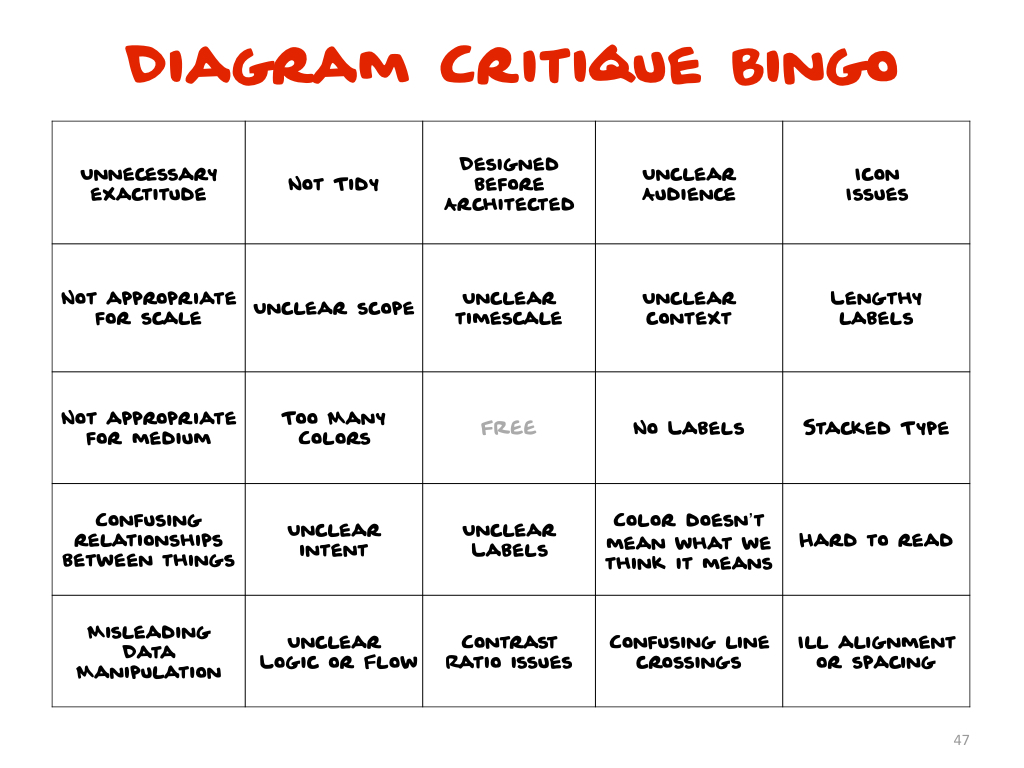Diagram Critique BINGO
Most days when I teach, I feel pretty useful. But today was my super power day. My favorite day of my teaching plan for this semester. Why? Because I unveiled my newest addition to my IA teacher toolbox: A BINGO game to help students to critique diagrams
I wanted to make this a game to do two things:
- To get my students talking about each other’s work using a common and agreed to language and set of standards
- To provide a useful framework of common issues diagrams suffer from so diagrammers can check themselves before presenting future diagrams
I got a magical unintended thing out of it too: I didn’t have to talk as much.
It felt good that I didn’t have to say much, because they knew a lot of what they needed to do to fix their own work and were able to verbalize it using the BINGO framework. I also found that as a group we could go deeper into our assessment of their work much more quickly because we had a framework of shared values.
Below are the common problems of diagrams that I used in making the BINGO card as well as instructions and a lecture deck on diagrammatic technique to prepare you for running this yourself with a class. I would love to hear about someone using this game play to critique diagrams in a work context, so if you have stories to share after playing, please let me know.
Common Diagrammatic Problems
Intent:
- Not appropriate to medium
- Not appropriate to scale
- Unclear scope
- Unclear context
- Unclear audience
Content:
- Unnecessarily Exact Figures (1.986676538% vs. 1.98%)
- Misleading Data Manipulation (1.98% vs. 2%)
- Designed before architected
- Unclear logic or flow
- Confusing relationship between things
- Unclear timescale
- Icon Issues
- Lengthy Labels
- No Labels
- Unclear Labels
Aesthetics:
- Backwards edge directions (like an upside-down book spine)
- Confusing or Crossing lines
- Contrast Ratio Issues
- Too many colors
- Color doesn’t mean what we think it means
- Not Tidy
- Stacked Type
- Ill Alignment or Spacing

How to Play: “Diagram Critique Bingo”
- Assign each student to design a diagram/map or info graphic for their homework
- Start with a lecture on diagrammatic technique (You may wonder why this is after the homework is done, I put it in this order so they would have lots of aha! reflections on what they do instinctually — I think it worked out nicely and would do it again in this order, but it’s not required to set it up like this)
- Put all the homework on the wall, crowd around expectantly, oohing and aahhhing at all the pretty diagrams
- Hand out Bingo Cards
- Go one at a time and allow each student to critique their own work using the BINGO card of common diagrammatic issues. They can claim as many squares as they want to say are issues with their own work. We timed each student’s feedback time at 5 minutes and this felt right.
- Once they are done with their own critique, let all the other students go for BINGO by critiquing their fellow student’s work
- Step back as your job as a teacher is almost done for you
The only thing I would change in doing this again would be adding candy. Because, candy.
Overall I highly recommend this activity for those looking to teach diagrammatic technique, I also think I will be hanging a BINGO card above my desk to remind me what to look for in critiquing my own work.
Thanks to my SVA Products of Design students for being awesome guinea pigs and trying out this new exercise.
